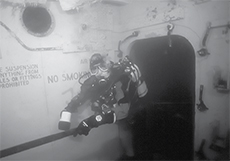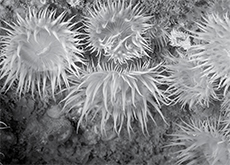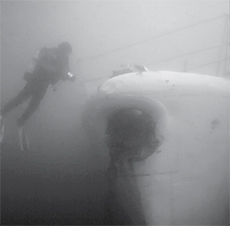




| Home | Features | Club Nights | Underwater Pics | Feedback | Non-Celebrity Diver | Events | 8 August 2025 |
| Blog | Archive | Medical FAQs | Competitions | Travel Offers | The Crew | Contact Us | MDC | LDC |

|

|
 
 |
 |
ISSUE 12 ARCHIVE - WRECK TO REEFDr John Carlin & Neville CopperthwaiteThe Importance of Artificial Reefs and a 'Wreck to Reef' Project In one of my previous articles on 'Wrecks versus Reefs' I wrote about wrecks that become artificial reefs. The Red Sea has some classic wrecks at the Abu Nuhas reef which are examples of where sea and reef have started to reclaim them. |
 |

|
Marine Biologists and conservationists are involved in projects to clean
and strip old ships before sinking them as artificial reefs to create new
habitats for marine life. Divers are keen to be involved as well, as not
only do they create an exciting new dive site but they can also take
some of the pressure of fishing and tourism away from natural reefs.
However man-made reefs are not an invention of the last decade. The Japanese have been building artificial reefs for the last four hundred years to try and improve dwindling fish stocks which are a global problem and one you will often hear as 'the inconvenient truth about the oceans'. If you have not yet had chance to watch the film 'The End of the Line' by Charles Glover I highly recommend it as it will open your eyes and will change the way you view sea food. |
|

|
An American non-governmental organisation (NGO) called the
Reef Ball Foundation in Georgia, is a publicly supported, non-profit
company that is working hard to re-habilitate reefs. Their mission
statement is to re-habilitate the world's ocean reef eco-systems to
protect the natural reef systems using 'Reef Balls'. Reef balls are made
from environmentally friendly concrete which has been designed
to last over five hundred years and have been tested so that they
cannot overturn in waves either by a small amount of weight or have
even been engineered so that they can be anchored to the seabed.
Although they come in over twenty different shapes and ten different
sizes, all the designs have holes to promote water circulation which
creates whirlpools to drive nutrients over the surface to animals and
plants living on or within the reef ball. They have protective voids for
fish to hide in and surface textures which encourage coral recruitment
and settlement so that in time the reef ball structure can no longer
be seen and will hopefully become an invisible skeleton.
|
 |

|
Over half a million reef balls have been made; there are over four
thousand different projects in fifty-nine different countries and it's
not just coral reef restoration that they have been used for. They
have been deployed for estuary restoration, red mangrove plantings,
oyster reef restoration and even for the erosion control of beaches.
In the Mediterranean artificial reefs are being used to protect valuable sea grass habitats from the destructive effects of commercial trawling. There is now even an official Association of Mediterranean Artificial Reef Scientists to manage this growing field of habitat management. Portugal has developed a reef system which is made up of seven areas that cover over 43km2 to try and improve their inshore fisheries industry. They are using large concrete cubes as a restocking tool to introduce hatchery-reared fish with the aim to increase the sea bream population. |
|
|
Here in the UK, we have numerous wrecks along our coast line, a
product of two World Wars and our rich maritime history. All the
wrecks from the Second World War are now disintegrating due to
a variety of reasons such as the effects of tidal movement and salt
water corrosion. These ships lying on the sea bed have become
reefs in their own right and are havens for marine life. As these
wrecks begin to disintegrate further and lose their shape, not only
do we, as divers, lose a great dive site, but we also lose that marine
habitat and the seas are poorer as a result.
Both around the world and here in the UK, artificial reefs have been used for a variety of reasons and can be beneficial both financially as well as environmentally. Canada, America, New Zealand and Australia have been sinking ships for divers and as angling attractions for the last thirty years. One of the most recent of these purpose-sunk wrecks was the USNS General Hoyt S. Vandenberg (T–AGM–10) which, on the 27th May 2009, became the world's second largest artificial reef (after the aircraft carrier USS Oriskany) when she was laid to rest at Key West in Florida. The Vandenberg has become a magnet for marine life and within six months was starting to become covered with plants and invertebrates. In Plymouth, England, the scuttling of HMS Scylla as an artificial reef has had a direct increase within the local economy and has reinvigorated the local dive industry. In reality this means people get to keep their jobs and new ones are created, this enables coastal communities to stay together and thrive. It hasn't always been plain sailing (excuse the water-related pun) for artificial reef projects though. Bad science and facts from Greenpeace prevented the one hundred and forty-five tonne North Sea oil platform 'Brent Spa' being sunk in 1995. They claimed that there was still five thousand tonnes of hydrocarbons and toxic waste within the structure. Greenpeace later admitted that they had got their calculations wrong. In 1985, the Rainbow Warrior, a Greenpeace ship, was sunk with the loss of a Greenpeace photographer Fernando Pereira, by French intelligence agents who were trying to prevent Greenpeace taking part in the protest against France's nuclear warhead testing at Moruroa (a French Polynesian Atoll). Once the Rainbow Warrior was refloated for forensic examination it was found it would be too expensive to repair and so it is with some irony that it was re-sunk as an artificial reef to promote marine life. I have been personally lucky enough to dive this wreck and it was encrusted with jewel anemones and alive with many different species of fish. As I surfaced, we had a pod of killer whales with a mother and small calf join us at the surface. The skipper said that quite often they would hang back in the gloom just watching divers and they were particularly interested in camera strobes and the noise they made when they recharged. He said the killer whales loved eating the giant sting rays which were plentiful in the area and had seen them whilst diving where they would swim over an area nose diving into a number sting rays and the sea bed to break their backs. They would then swim back over the area scooping them up and eating them like crisps. |
 | |
|
The most exciting new project for an artificial reef in the UK is being
co-ordinated by Neville Copperthwaite and O'Three for the Weymouth
and Portland 'Wreck to Reef' Project (W2R). Neville was employed by
the UK Department of the Environment as a professional diver and after
observing dwindling lobster stocks he pioneered lobster restocking in
the UK and established Britain's first commercial Lobster Hatchery at
Portland. He now has a Marine Consultancy and Survey business and
is the Project Coordinator of 'Wreck to Reef'.
Neville writes that "as a social enterprise project there is nothing like an artificial reef to catalyse people, from the academic to the layman; we all look the same in a diving suit and we are all interested in the wellbeing of our underwater environment. And at W2R we have realised that it should be this cross section of society that should be involved with the management of these areas." The W2R project will attempt to redress the loss of habitat by destructive fishing practices, such as bottom trawling, by pioneering a new concept in artificial reef areas by drawing on the worldwide experiences mentioned above to create a multifunctional reef area. In this case, they propose to sink ships as diver attractions surrounded by a smaller reef material, such as locally crushed and graded stone, to restock with juvenile lobsters for the local Fishery. W2R is currently in talks with the Head of the Disposal Services Authority (DSA) with regards to acquiring HMS Southampton, a Type 42 Destroyer that has recently been de-commissioned. Of course, how do you go about getting the funding required to purchase a ship of this size? In Australia the government donates decommissioned naval ships to dive organisations by 'Deed of Gift', in order to scuttle as dive attractions. The market scrap value of a Type 42 Destroyer is around £300,000, however as an artificial reef it would bring an estimated return of £5,000,000 or more to the economy in the locality of the scuttling, on an annual basis for many years. This figure is taken from a report by the Devon and Cornwall Business Council who point out that the scuttling of HMS Scylla has increased the local economy by £25 million to £30 million during the last five years. The local MP, Richard Drax, has been a great champion of the W2R project since its inception and is very supportive of the Governmental Deed of Gift Idea. He has written to Mike Penning MP, Under Secretary of State at the Department for Transport to promote this idea and seek support. The wrecks that will be sunk in the area will also be placed facing southwards to avoid excessive movements in storms and to allow divers to have a lee side whichever way the tides are running. |
 | |
|
The Southern South Sea Fishery District is now interested in the
possibility of incorporating lobster restocking reefs within the 'W2R'
area and there are plans to place six thousand juvenile lobsters annually
so that they can grow and repopulate the surrounding region.
Concrete or Portland stone will be used to incorporate a sculpture area which will hook-in (another water-related pun) the artistic community in the area as well as broaden the undersea interest base. The idea is not only to attract wreck divers but also those who are interested in marine life, have a passion for conservation and exciting opportunities for underwater photography and videography. The Crown Estate has now agreed a lease with the Dorset County Council agreeing to be the statutory sea-bed lease holder which will then sub-lease to the W2R project. Southampton University is completing the Environmental Impact Assessment and the Marine Management Organisation has appointed a case officer to work with the W2R team to oversee what will be a five year project. There are some that say that we should not interfere with nature. However, we have already unbalanced the oceans by over fishing and pollution and whilst we attempt to try and restrict fishing to give the aquatic realm time to recover we will never stop it. If we were to look at terrestrial farming as a comparative example it would not be sustainable without putting something back into the land, but precious little is done to replace what is taken from the seas. Artificial reefs are one of the few proactive tools that are currently employed within the marine environment to give nature a helping hand. The final words of this article go to Neville Copperthwaite, "I would just like to say that the strength of the W2R Project lies within our people, our community. The W2R seabed area will be managed and steered by the people that use it or take an interest in it. We will establish a working group, a consultative group, call it what you will, but it will consist of divers, commercial fishermen, sailors, people from the tourism industry, naturalists, artists and people from local government and our institutions; and of course, undertakers. The success of our progress so far indicates that this will work and that an inclusive approach to management of our sea is the way forward." To find out more and how to get involved visit the W2R website. You can also send a letter to Oliver Letwin (current Minister of State at the Cabinet Office, and a Member of Parliament, representing the constituency of West Dorset) to petition for a Deed of Gift for the HMS Southampton: The Right Honourable Oliver Letwin MP, Cabinet Office, 70 Whitehall, London SW1A 2AS |
 | |
Previous article « Sharkipedia Next article » An Armchair Diver's Guide to Technical Courses Back to Issue 12 Index | ||